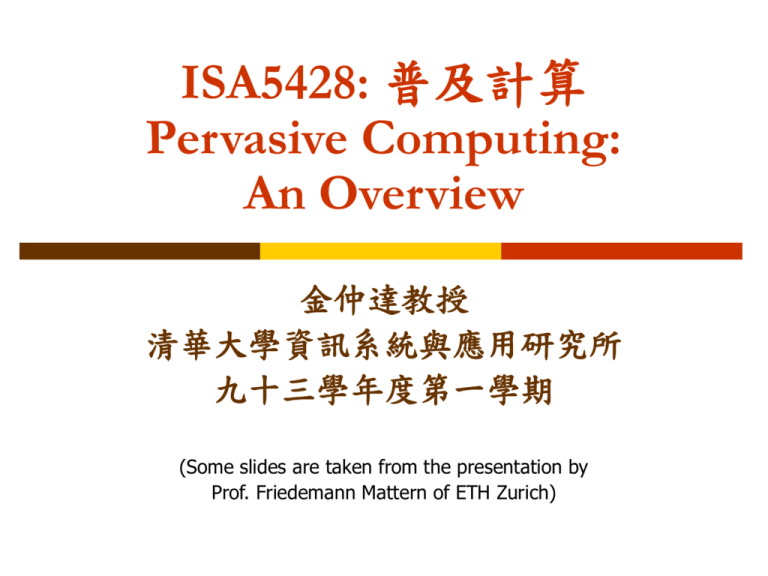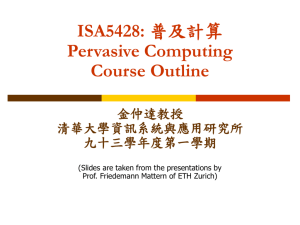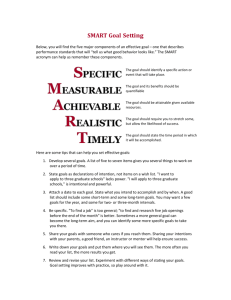A Survey of Context-Aware Mobile Computing Research
advertisement

ISA5428: 普及計算 Pervasive Computing: An Overview 金仲達教授 清華大學資訊系統與應用研究所 九十三學年度第一學期 (Some slides are taken from the presentation by Prof. Friedemann Mattern of ETH Zurich) Outline The Vision -- According to Mark Weiser The Enablers Example Projects Summary Overview-1 Pervasive Computing According to Mark Weiser Overview-2 Transparencies Are Taken from Mark Weiser's slides for the keynote speech "Building Invisible Interfaces" given at the User Interface, Systems, and Technologies (UIST) Conference, November, 1994. Mark Weiser’s slides from the invited talk: "Does Ubiquitous Computing Need Interface Agents? No." given at the MIT Media Lab Symposium on User Interface Agents, October 1992. M. Weiser’s paper “The Computer for the 21st Century,” Scientific American, Sept. 1991. Overview-3 Your Personal Experience Remember the last time you spent several productive hours? It had some characteristics: Time passed unnoticed You were unaware of your surroundings Consciously you focused on a goal Unconsciously you drew on tacit skills and knowledge The situation was very rich with details and nuances that you unconsciously took into account The things you did not think about – the tacit, the context, the world – made you smart! Overview-4 A Basic Characteristic of Human People are most effective and authentic when they are fully engaged, mind and body, in the world Examples: Flow of the athlete in the groove Effortless use of pencil, paper and language when writing Effortless 65 MPH driving of the experienced driver (while talking, reading road signs, …) Technologies should enhance this ability to engage, to “flow” with life and work Overview-5 Invisible Technologies The most powerful technologies are invisible: Electricity they get out of the way to let human be effective Electric motors hidden everywhere (20-30 per car) Electric sockets in every wall and portably available through batteries Integrated, invisible infrastructure Literary technology Continuously surrounding us at many scales: books, newspapers, street signs, candy wrappers Used trivially and profoundly Literally visible, effectively invisible Overview-6 Good Technology Is Invisible “Invisible” stays out of the way of task Bad technology draws attention to itself, not task Like a broken, or skipping, or dull pencil Like a car that needs a tune-up Computers are mostly not invisible Like a good pencil stays out of the way of the writing Like a good car stays out of the way of the driving They dominate interaction with them Ubiquitous computing is about “invisible computers” Overview-7 How to Do Invisible Computing? Integrated computer systems approach Invisible, everywhere, computing named “ubiquitous computing” in April 1989 Invisible: tiny, embedded, attachable, … Everywhere: wireless, dynamically configurable, remote access, adapting, … Overview-8 Overview-9 Goals of Ubiquitous Computing Ultimate goal: Invisible technology Integration of virtual and physical worlds Throughout desks, rooms, buildings, and life Take the data out of information, leaving behind just an enhanced ability to act Overview-10 Ubicomp Phase I Phase I Smart, ubiquitous I/O devices: tabs, pads, and boards Hundreds of computers per person, but casual, lowintensity use Many, many “displays”: audio, visual, environmental Wireless networks Location-based, context-aware services Interesting scenarios Using a computer should be as refreshing as a walk in the woods Overview-11 Smart Objects Real world objects are enriched with information processing capabilities Embedded processors Communication capability in everyday objects small, cheap, lightweight wired or wireless spontaneous networking and interaction Sensors and actuators Overview-12 Smart Objects (cont.) Can remember pertinent events Show context-sensitive behavior They have a memory They may have sensors Location/situation/context awareness Are responsive/proactive Communicate with environment Networked with other smart objects Overview-13 Smart Objects (cont.) Overview-14 Ubiquitous Computing Vision “In the 21st century the technology revolution will move into the everyday, the small and the invisible…” “The most profound technologies are those that disappear. They weave themselves into the fabrics of everyday life until they are indistinguishable from it.” Mark Weiser (1952 –1999), XEROX PARC Small, cheap, mobile processors and sensors in almost all everyday objects on your body (“wearable computing”) embedded in environment (“ambient intelligence”) Overview-17 Outline The Vision -- According to Mark Weiser The Enablers Example Projects Summary Overview-18 First Enabler: Moore‘s Law Processing speed and storage capacity double every 18 months “cheaper, smaller, faster” Exponential increase will probably go on for the next 10 years at same rate Overview-19 Generalized Moore’s Law Most important technology parameters double every 1– 3 years: computation cycles memory, magnetic disks bandwidth Problems: • increasing cost • energy Consequence: scaling down Overview-20 2nd Enabler: Communication Bandwidth of single fibers ~10 Gb/s Powerline coffee maker “automatically” connected to the Internet Wireless 2002: ~20 Tb/s with wavelength multiplex (often at no cost for laying new cable!) mobile phone: GSM, GPRS, 3G wireless LAN (> 10 Mb/s) Bluetooth Room networks, body area networks Internet-on-a-chip Overview-21 Ubiquitous Information PAN: Personal area network Overview-22 Body Area Networks Very low current (some nA), some kb/s through the human body Possible applications: Car recognize driver Pay when touching the door of a bus Phone configures itself when it is touched Overview-23 Spontaneous Networking Objects in an open, distributed, dynamic world find each other and form a transitory community Devices recognize that they “belong together” Overview-24 3rd Enabler: New Materials Important: whole eras named after materials More recently: semiconductors, fibers change the external appearance of computers “Plastic” laser information and communication technologies Organic semiconductors e.g., “Stone Age”, “1st generation computers” Opto-electronics, flexible displays,… ... Overview-25 Smart Paper, Electronic Ink Electronic ink micro capsules, white on one side and black on the other oriented by electrical field substrate could be an array of plastic transistors Potentially high contrast, low energy, flexible Interactive: writable with magnetic pen Overview-26 Interactive Map Foldable and rollable You are here! Overview-27 Smart Clothing Conductive textiles and inks print electrically active patterns directly onto fabrics Sensors based on fabric e.g., monitor pulse, blood pressure, body temperature Invisible collar microphones Kidswear game console on the sleeve? integrated GPS-driven locators? integrated small cameras (to keep the parents calm)? Overview-28 Smart Glasses By 2009, computers will disappear. Visual information will be written directly onto our retinas by devices in our eyeglasses and contact lenses -- Raymond Kurzweil Overview-29 Today’s Wearable Computer ready to ware Overview-30 Wearable Concept (Motorola) Overview-31 4th Enabler: Sensors/Actuators Miniaturized cameras, microphones,... Fingerprint sensor Radio sensors RFID Infrared Location sensors e.g., GPS ... Overview-32 Example: Radio Sensors No external power supply energy from the actuation process piezoelectric and pyroelectric materials transform changes in pressure or temperature into energy RF signal is transmitted via an antenna (20 m distance) Applications: temperature surveillance, remote control (e.g., wireless light switch),... Overview-33 RFIDs (“Smart Labels”) Identify objects from distance small IC with RFtransponder Wireless energy supply ~1m magnetic field (induction) ROM or EEPROM (writeable) ~100 Byte Cost ~$0.1 ... $1 consumable and disposable Flexible tags laminated with paper Overview-34 Bar Code Reader PDAs, mobile phones, and wireless Internet appliances become request devices for information find information order products ... Overview-35 Lego Making Lego Smart: Robot command Explorer (Hitachi H8 CPU, 32KB RAM, IR) Overview-36 Lego Mindstorms Overview-37 Putting Them Altogether Progress in computing speed communication bandwidth material sciences sensor techniques computer science concepts miniaturization energy and battery display technologies ... Enables new applications “Post-PC era” business opportunities Challenges for computer scientists, e.g., infrastructure Overview-38 Outline The Vision The Enablers Example Projects Summary Overview-39 Idea: Making Objects Smart The Smart Its Project Vision: make everyday objects as smart, interconnected information artifacts by attaching “Smart-Its” Smart labels Atmel microcontroller: (ETH Zurich) 4 MIPS, 128 kB flash Overview-40 “Smart-Its Friends” How do we establish that two objects “belong together”? Hold them together and shake! Overview-41 “Smart-Its Friends”! After the shared context has been established, the two devices can open a direct communication link to exchange applicationspecific data Overview-42 Idea: Virtual Counterparts Virtual World (Internet, cyberspace) Pure virtual objects Real World (e.g., every object has a web server) Overview-43 Ex.: As Artifact Memories Updates triggered by events Queries from the real world return memory content Sensors generate events Overview-44 Magnifying Glass An object as a web link e.g., by displaying a dynamically generated homepage Contents may depend on circumstances, e.g., context and privileges possibly mediated by different name resolvers HP Cooltown project Overview-45 CueCat & Its Business Models Bar code scanner Scanners distributed free LED based Attached to computer via keyboard port $5-$10 per CueCat Sends the Web browser directly to “right” location when scanning the bar code of an ad in a magazine Overview-46 Other Applications Physical browsing (physical entity as an icon or URL link to web pages) Physical objects as content repositories (by associating objects with content) Copy-and-paste in the real world Objects as communication points (by communicating content between two persons) Objects as physical representation of virtual state, mixed reality, smart environment Overview-47 Smart Environment, Dumb Object A context-sensitive cookbook with RFID RFID Overview-48 Can be Context-Aware Properties of the ingredients Properties of the kitchen Check whether there is enough of an ingredient Prefer ingredients with earlier best-before date Check whether required tools and spices are available Preferences and abilities of the cook Prefers Asian dishes Expert in vegetarian dishes Overview-49 AT&T Sentient System Timeline-based context storage Location tracking Position monitoring Overview-50 MIT Oxygen Project Overview-51 Berkeley’s Wireless Sensor Network MICA Motes, sensors, and TinyOS: Overview-52 Other Opportunities New digitally enhanced products New services (“e-utilities”) e.g., cooperating toys, air conditioner, ... e.g., management of smart devices at home, management of personal privacy,... Detailed and timely knowledge of product location and life cycles, individual and dynamic prices for goods,... e.g., milk bottle reduces its price with its age e.g., higher taxes if product transported by plane Overview-54 Outline The Vision The Enablers Example Projects Summary Overview-55 New Science from Exploring Ubicomp Theoretical computer science: network security, caching over slow networks, … Operating systems: scalable to wristwatches, userextensible O.S.’s, reliable without redundancy, low power O.S. User interfaces, hardware and software gestures, twohanded input, pie-menus, unistroke alphabets Networking, hardware and software: radio, infrared, mobile protocols, in-building wireless LANs, over varying bandwidth Computer architecture, hardware and software: post-itnote computers, low power O.S., multimedia pad computers Overview-57 Summary Ubiquitous computing emphasizes metaphors of life, interaction with other people, invisibility, and is leading to new discoveries in computer science “Using a computer should be as refreshing as taking a walk in the woods.” Overview-58




